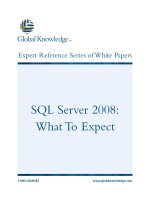What to expect on the gmat 5 potx
Bạn đang xem bản rút gọn của tài liệu. Xem và tải ngay bản đầy đủ của tài liệu tại đây (87.59 KB, 6 trang )
Sentence correction questions are designed to measure your knowledge of both grammar and effective style.
Chances are you already know most of these rules and guidelines even if you don’t know how to articulate
them. You can often tell when something sounds wrong, even if you don’t know exactly why it is wrong. That
is good news because on the GMAT® exam you do not have to identify the grammar rule that has been bro-
ken or what makes the writing ineffective. Rather, you will simply have to identify which sentence is free of
errors and written most effectively.
That said, you can still benefit a great deal from a review of the basic rules of grammar and guidelines
for effective style, especially if you feel that grammar is not your strong suit. You may find some sections here
more basic than you need, but give yourself the opportunity to review everything in this section. You may find
that you have forgotten some rules and guidelines, and a review of the rules and terminology can give you
more confidence on the exam.
CHAPTER
Sentence
Correction
7
109
24 Rules for Grammar and Style
Throughout this chapter, you will learn about and review each of these rules in depth. After you have completed
the chapter, use the following list as a checklist as you review for the GMAT exam:
1. Follow the basic subject-predicate word order for sentences: subject, verb, indirect object, and direct
object.
2. Make sure sentences have both a subject and a predicate and express a complete thought.
3. Respect sentence boundaries. Do not let two or more independent clauses run together.
4. Keep modifiers as close as possible to the words they modify.
5. Use parallel structure for any series of actions or items or the not only/but also construction.
6. Make sure verbs agree in number with their subjects.
7. Keep verb tenses consistent.
8. Use the correct subject or object form of personal pronouns. Determine whether a pronoun is function-
ing as a subject or object in the sentence.
9. Use apostrophes with pronouns to show contraction only. Pronouns do not need apostrophes to show
possession.
10. Use who for people, that for things, and which for nonessential clauses that do not refer to people.
11. Make sure pronouns agree in number and person with their antecedents.
12. Be consistent in pronoun point of view.
13. Use less (meaning a smaller amount) for singular nouns representing quantity or degree. Use fewer
(meaning a smaller number) for plural nouns and countable items.
14. Use good and bad to modify nouns and pronouns; use well and badly to modify verbs.
15. In comparisons, add -er or -est to short modifiers. For longer words, use more/the most or less/the least
before the modifier.
16. Do not use double comparisons.
17. Do not use double negatives.
18. Use idioms correctly.
19. Be concise. Avoid unnecessary repetition or wordiness.
20. Be precise. Use exact words.
21. Avoid ambiguity. Make sure word choice and pronoun references are clear and modifiers properly
placed.
22. In general, use the active voice.
23. Use variety in sentence structure.
24. Avoid jargon and pretentious language.
110
Sentence Structure
The best place to begin a grammar review is with the basics of sentence construction. Although you will not
need to diagram a sentence on the GMAT exam, understanding the fundamentals of sentence structure can
help you better remember the rules of grammar and style.
Sentence structure refers to the way sentences are composed: how subjects, verbs, objects, and modi-
fiers are strung together in clauses and phrases. Awkward or incorrect placement of phrases and clauses can
result in sentences that are confusing, unclear, or say things that you do not mean. Indeed, many sentences
on the GMAT exam will be wrong precisely because of misplaced sentence elements. Sentence structure is also
important to style. If sentence structure is too simple or repetitive, the writing becomes monotonous for the
reader. (Style will be addressed later in this section.)
Subjects, Predicates, and Objects
The sentence is the basic unit of written expression. It consists of two essential parts
—
a subject and a pred-
icate
—
and it must express a complete thought. The subject of a sentence tells the reader who or what the sen-
tence is about
—
who or what is performing the action of the sentence. The predicate tells the reader something
about the subject
—
what the subject is or does. Consider the following sentence:
The clock is ticking.
The word clock is the subject. It tells you what the sentence is about
—
who or what performs the action
of the sentence. The verb phrase is ticking is the predicate. It tells you the action performed by (or informa-
tion about) the subject.
The subject of a sentence can be singular or compound (plural):
I
slept all day. Kendrick and I worked all night.
singular subject compound subject (two subjects performing the action)
The predicate can also be singular or compound:
I r
eceived a bonus.I received a bonus and got a raise.
singular predicate compound predicate (two actions performed by the subject)
Subject-predicate is the fundamental word order of sentences. When this order is reversed, the result is
an awkward and perhaps unclear sentence such as the following:
A bonus I received.
– SENTENCE CORRECTION–
111
In such a short sentence, the meaning is often clear despite the awkward word order. However, in longer
sentences, when the subject and predicate are reversed, the sentence can be quite confusing, as in the following
sentence from the pretest:
Creating a fundamental shift in American foreign policy and establishing a “policy of containment” that
framed our foreign policy as a battle between the forces of good (America and other democratic soci-
eties) and evil (the Soviet Union and other communist nations), was the 1947 Truman Doctrine.
In many sentences, someone or something “receives” the action expressed in the predicate. This person
or thing is called the direct object. In the following sentences, the subject and predicate are separated by a
slash (/) and the direct object is underlined:
I / bought a present. (The present receives the action of being bought.)
Jane / loves ice cream. (Ice cream receives the action of being loved by Jane.)
Sentences can also have an indirect object: a person or thing who “receives” the direct object. In the fol-
lowing sentences, the direct object is underlined and the indirect object is in bold:
I / gave Sunil a r
aise. (Sunil receives the raise; the raise receives the action of being given.)
The student / asked the professor a quest
ion. (The professor receives the question; the question
receives the action of being asked.)
Rule #1: Follow the basic subject-predicate word order for sentences: subject, verb, indirect object, and
direct object.
Independent and Dependent Clauses
A clause contains a subject and a predicate and may also have direct and indirect objects. An independent
clause expresses a complete thought; it can stand on its own as a sentence. A dependent clause, on the other
hand, cannot stand alone because it expresses an incomplete idea. When a dependent clause stands alone, it
results in a sentence fragment.
Independent clause: She was excited.
Dependent clause: Because she was excited.
Notice that the dependent clause is incomplete; it needs an additional thought to make a complete
sentence:
S
he spoke very quickly because she was excited.
The independent clause, however, can stand alone. It is a complete thought.
– SENTENCE CORRECTION–
112
SUBORDINATING CONJUNCTIONS
A subordinating conjunction such as the word because makes a dependent clause dependent. Subordinating
conjunctions connect clauses and help show the relationship between those clauses. The following is a list of
the most common subordinating conjunctions:
after even though that when
although if though where
as, as if in order that unless wherever
because once until while
before since
When a clause begins with a subordinating conjunction, it is dependent. It must be connected to an
independent clause to become a complete thought:
I never knew true happiness until I met you.
independent clause dependent clause
After Johnson quit, I had to work extra overtime.
dependent clause independent clause
CONJUNCTIVE
ADVERBS
A very common grammar mistake is to think that words such as however and therefore are subordinating con-
junctions. But however and therefore belong to a group of words called conjunctive adverbs, which also sig-
nal relationships between parts of a sentence. When they are used with a semicolon, they can combine
independent clauses. The following is a list of the most common conjunctive adverbs:
also indeed now
anyway instead otherwise
besides likewise similarly
certainly meanwhile still
finally moreover then
furthermore namely therefore
however nevertheless thus
incidentally next undoubtedly
I did not go to the party; inst
ead, I stayed home and watched a good film.
Samantha is a fabulous cook; indee
d, she may even be better than Jacque.
I need to pay this bill immediately. Othe
rwise, my phone service will be cut off.
– SENTENCE CORRECTION–
113









